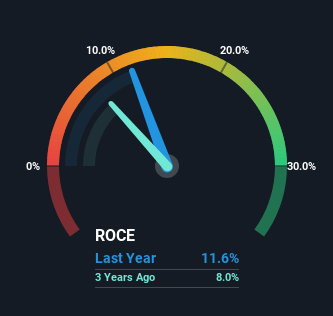If we want to find a stock that could multiply over the long term, what are the underlying trends we should look for? Typically, we'll want to notice a trend of growing return on capital employed (ROCE) and alongside that, an expanding base of capital employed. This shows us that it's a compounding machine, able to continually reinvest its earnings back into the business and generate higher returns. So when we looked at DS Smith (LON:SMDS) and its trend of ROCE, we really liked what we saw.
What Is Return On Capital Employed (ROCE)?
Just to clarify if you're unsure, ROCE is a metric for evaluating how much pre-tax income (in percentage terms) a company earns on the capital invested in its business. The formula for this calculation on DS Smith is:
Return on Capital Employed = Earnings Before Interest and Tax (EBIT) ÷ (Total Assets - Current Liabilities)
0.12 = UK£747m ÷ (UK£9.5b - UK£3.0b) (Based on the trailing twelve months to April 2023).
So, DS Smith has an ROCE of 12%. That's a pretty standard return and it's in line with the industry average of 12%.
View our latest analysis for DS Smith

Above you can see how the current ROCE for DS Smith compares to its prior returns on capital, but there's only so much you can tell from the past. If you'd like, you can check out the forecasts from the analysts covering DS Smith here for free.
What Does the ROCE Trend For DS Smith Tell Us?
DS Smith is displaying some positive trends. The numbers show that in the last five years, the returns generated on capital employed have grown considerably to 12%. The amount of capital employed has increased too, by 50%. This can indicate that there's plenty of opportunities to invest capital internally and at ever higher rates, a combination that's common among multi-baggers.
Our Take On DS Smith's ROCE
To sum it up, DS Smith has proven it can reinvest in the business and generate higher returns on that capital employed, which is terrific. Astute investors may have an opportunity here because the stock has declined 34% in the last five years. So researching this company further and determining whether or not these trends will continue seems justified.
DS Smith does have some risks, we noticed 2 warning signs (and 1 which is a bit unpleasant) we think you should know about.
While DS Smith isn't earning the highest return, check out this free list of companies that are earning high returns on equity with solid balance sheets.
New: Manage All Your Stock Portfolios in One Place
We've created the ultimate portfolio companion for stock investors, and it's free.
• Connect an unlimited number of Portfolios and see your total in one currency
• Be alerted to new Warning Signs or Risks via email or mobile
• Track the Fair Value of your stocks
Have feedback on this article? Concerned about the content? Get in touch with us directly. Alternatively, email editorial-team (at) simplywallst.com.
This article by Simply Wall St is general in nature. We provide commentary based on historical data and analyst forecasts only using an unbiased methodology and our articles are not intended to be financial advice. It does not constitute a recommendation to buy or sell any stock, and does not take account of your objectives, or your financial situation. We aim to bring you long-term focused analysis driven by fundamental data. Note that our analysis may not factor in the latest price-sensitive company announcements or qualitative material. Simply Wall St has no position in any stocks mentioned.
About LSE:SMDS
DS Smith
Provides packaging solutions, paper products, and recycling services worldwide.
Slight with moderate growth potential.
Similar Companies
Market Insights
Community Narratives



